Scientific research and quality standards needed to enhance Vietnamese ginseng’s value
Society – Economy - Ngày đăng : 11:24, 06/07/2024
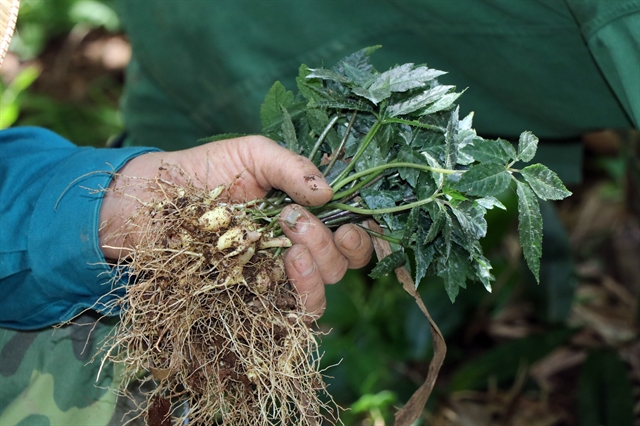 |
| Workers from Ngọc Linh Kon Tum Ginseng Joint Stock Company (unseen) are harvesting ginseng seedlings at the nursery for planting. VNA/VNS Photos Cao Nguyên |
As one of the countries possessing the world's most valuable ginseng genetic resources, Việt Nam faces significant limitations in the conservation and development of ginseng due to a lack of scientific research on ginseng varieties and quality standards.
Establishing quality standards for this precious medicinal herb and its products is essential to ensure that Vietnamese ginseng meets international regulations and practices, thereby enhancing its competitiveness with other types of ginseng on the market.
This, in turn, lays the groundwork for researching and developing Vietnamese ginseng into a national brand, experts say.
Vũ Đức Lợi, PhD, director of the Việt Nam-Korea Institute of Science and Technology (VKIST), says that many scientific studies have proven that Vietnamese ginseng has a chemical composition and pharmacological effects comparable to other precious ginseng species worldwide.
As an endemic species and as a precious medicinal herb, Vietnamese ginseng has been included in the national product list by the Government since 2017.
Vietnamese ginseng, scientifically known as Panax vietnamensis Ha & Grushv, is one of the 12 species in the Panax genus of the Araliaceae family. It was first discovered in the wilds in the Ngọc Linh mountains of Kon Tum and Quảng Nam provinces in 1973, and was officially documented in botanical terms in 1985.
In Việt Nam, three varieties of Panax vietnamensis have been identified, including Ngọc Linh ginseng, Lai Châu ginseng and Langbiang ginseng.
Vietnamese ginseng has been successfully propagated, cultivated and developed to serve the development of health care products for Vietnamese people.
Lợi says that quality standards for ginseng and health care products derived from ginseng have been established and included in various countries' compound medical books, including Việt Nam's.
As consumer demand for product quality increases, alongside advancements in science and technology, it is essential to continuously update the quality standards for ginseng and its products to control active ingredient content with increasing precision.
"For Vietnamese ginseng to compete with other ginseng species on the market, it must have clear, modern and reliable quality standards," Lợi says.
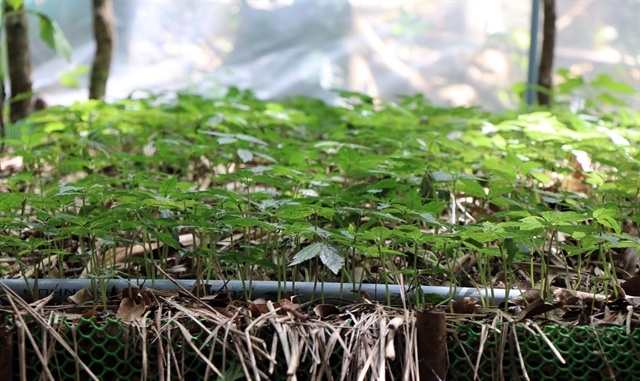 |
| The Ngọc Linh ginseng nursery at Ngọc Linh Kon Tum Ginseng Joint Stock Company. |
According to Lê Quang Thảo, PhD, from the Ministry of Health’s National Institute of Drug Quality Control, the quality of Vietnamese ginseng is a matter of great concern.
Currently, Ngọc Linh ginseng costs around VNĐ200-300 million (US$7,850-11,780) per kilogram and Lai Châu ginseng costs around VNĐ80-100 million ($3,140-3,920) per kilogram.
Meanwhile, Tam thất hoang (Vietnamese wild ginseng or Panax notoginseng) resembles Ngọc Linh ginseng in appearance, and Lai Châu ginseng is very similar to Ngọc Linh ginseng in both appearance and chemical composition. Therefore, there is a high risk of counterfeit products on the market.
“This requires methods to distinguish these types of ginseng,” Thảo says.
A representative of the Quảng Nam People’s Committee [provincial government] says that there are currently no specific guidelines or regulations to differentiate between wild Ngọc Linhginseng and farmed Ngọc Linh ginseng.
This lack of clarity poses significant challenges in advising and proposing the issuance of codes for cultivation facilities for wild Ngọc Linh ginseng and in developing the production, business and export of farm grown Ngọc Linh ginseng. As a result, it affects the development and management of Ngọc Linh ginseng cultivation in the province.
 |
| Analysing ginseng samples for individual Saponin components. |
Another problem is that Việt Nam has not yet released specific guidelines to issue or manage planting area codes for Ngọc Linh ginseng. Additionally, the workforce dedicated to researching and developing Ngọc Linh ginseng are limited, making it difficult to support the development of Ngọc Linh ginseng. Investment in research and the application of science and technology for developing Ngọc Linh ginseng remains insufficient.
According to the Quảng Nam authorities, the conservation and development of Ngọc Linh ginseng in the province has not been systematically done, which is why ginseng has not yet been successfully commercialised.
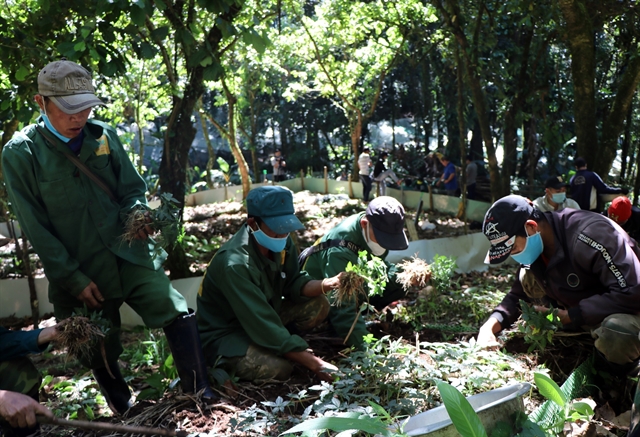 |
| Workers from the Ngọc Linh Ginseng Joint Stock Company planting ginseng on Ngọc Linh mountain in Kon Tum Province. |
Phương Thiện Thương, PhD, deputy director of the VKIST, says that South Korea's ginseng industry reached a value of $2.7 billion in 2023.
According to the Ministry of Health, the economic value of medicinal herbs in Việt Nam is about $500 million, or only about one-fifth of the value of South Korea's ginseng industry.
“This underscores the necessity of establishing quality standards for ginseng medicinal herbs,” he says.
Pyo Mi Kyung from the Geumsan International Ginseng & Herb Research Institute in South Korea says that there they have their own Ginseng Industry Act, which includes standards for ginseng production, quality inspection, product specifications and ginseng-based functional foods.
Beyond national laws, there are also local standards, such as those from the Geumsan region, which are even more specific, stringent and hard to match compared to national standards.
Enhancing scientific ginseng research
Sharing additional experiences on the development of the ginseng industry in South Korea, Prof Park Jeong Hill from Seoul National University says that South Korea has a group of scientists dedicated to ginseng research, the Korean Society of Ginseng (KSG), which has approximately 1,200 members. The KSG supports 20-30 research projects annually, with a total funding of $1-1.5 million per year.
Annually, over 600 publications on Korean ginseng are released, by contrast there are about ten publications on Vietnamese ginseng each year.
After examining Vietnamese ginseng, Prof Park recommended that Việt Nam develop standardised cultivation methods. Currently, the cultivation techniques for Vietnamese ginseng are underdeveloped, with low yield per unit area, small numbers of farms and limited cultivation areas.
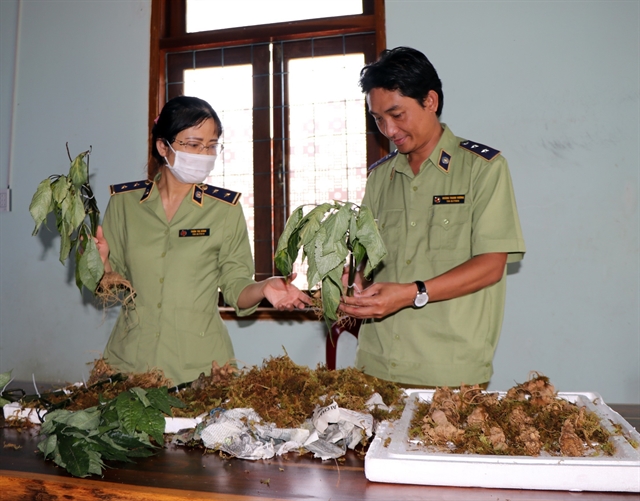 |
| The Kon Tum Provincial Market Management Department's Market Management Team No 2, in coordination with the Đăk Tô District police, discovered a case of smuggling various types of roots disguised as Ngọc Linh ginseng from northern provinces into Đăk Tô District. |
According to Prof Park, scientific research on Vietnamese ginseng is currently limited. It is crucial to enhance research efforts as scientific evidence of the quality and benefits of Vietnamese ginseng to generate demand.
Additionally, there is a need to study the chemical composition, biological activity and quality control of ginseng, he says.
Việt Nam should also focus on protecting the genetic resources, as Vietnamese ginseng only grows in high mountainous areas and has significant genetic diversity.
He also emphasises that collaboration between scientists and farmers, with government support, is essential for the development of Vietnamese ginseng.
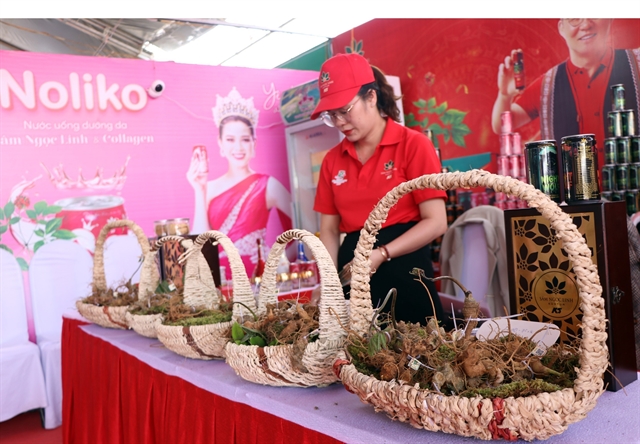 |
| Ngọc Linh ginseng products at the Ngọc Linh Ginseng Fair at Tu Mơ Rông District Centre in Kon Tum Province. |
Highlighting the prospects of Lai Châu ginseng, Phạm Hà Thanh Tùng, PhD, at the Việt Nam Institute of Ginseng and Medicinal Herbs says that the MARD has granted plant variety protection for Lai Châu ginseng and the Intellectual Property Office under the Ministry of Science and Technology has issued a certification trademark for Lai Châu ginseng.
Currently, 19 organisations and 217 households are cultivating a total area of 60 hectares of Lai Châu ginseng, along with many smaller, dispersed ginseng plots totalling about 19 hectares under the forest canopy. By 2030, the total area under Lai Châu ginseng in the province is expected to reach about 3,000 hectares, meeting GACP standards.
According to Tùng, it is essential to further promote and develop Lai Châu ginseng, complete the scientific database on ginseng and establish quality standards and products derived from Lai Châu ginseng.
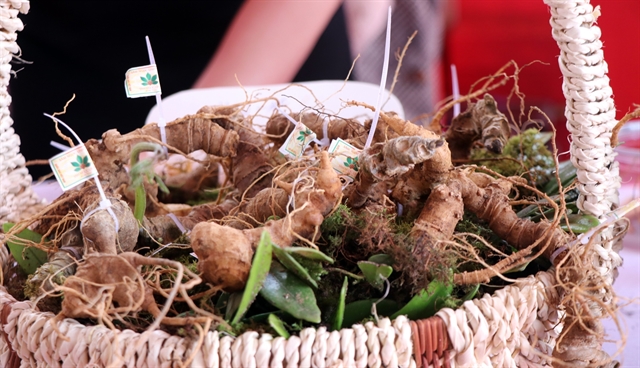 |
| Ngọc Linh ginseng roots win consumers' trust. |
Deputy Minister of Science and Technology Bùi Thế Duy says that the ministry has made investments in Vietnamese ginseng. This is demonstrated by the geographical indication protection for Ngọc Linh ginseng, the establishment of research institutes and centres for Ngọc Linh ginseng in Kon Tum, quality verification support and State management activities to ensure the quality of ginseng, combat counterfeit goods and include Vietnamese ginseng in the list of national products prioritised for research and development.
With the help of Korean experts, the VKIST has successfully transferred technology to domestic enterprises, particularly focusing on high-content herbal extraction technology.
However, Duy says more should be done to enhance collaboration between Vietnamese enterprises, localities, scientists and research institutes to bring the best technologies and valuable lessons from Korean ginseng to Vietnamese ginseng.
This collaboration will help research projects, technology transfer and cooperative production projects between South Korea and Việt Nam regarding ginseng, he adds. VNS
